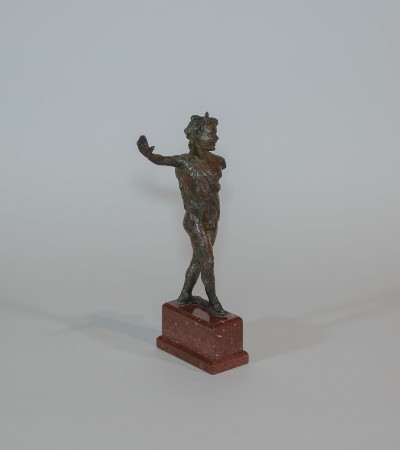
Dancing Satyr
Dancing Satyr
Roman, 1st century CE
Solid-cast bronze
8 7/16 in. x 4 5/8 in. x 2 1/2 in. (21.5 cm. x 11.75 cm. x 6.35 cm.)
Gift of Edward Perry Warren, Esq., Honorary Degree, 1930.215
This statuette depicts a youthful satyr, half-man and half-goat, who is a follower of Dionysus, the god of theater and wine. Like Dionysus himself, satyrs were also associated with theatrical performances. The figure is identifiable by a panther skin draping the torso, an ivy wreath worn as a crown, and his short tail. Depicted in a moment of joyful, and perhaps inebriated, dancing, his eyes softly gaze upward to his left as his partially open mouth with its upturned corners captures a sly smile. Similar bronze and marble representations of satyrs often embellished Roman domestic spaces such as gardens, where they were appreciated for their ornamental and decorative quality.
(B. Wrubel)

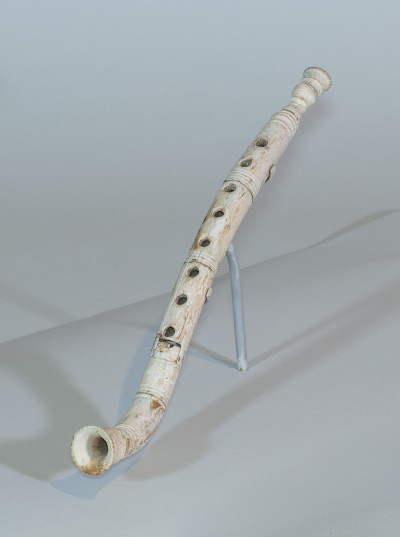
Flute or "Phrygian Aulos"
Flute or "Phrygian Aulos"
Roman, 1st-2nd century CE
Ivory/bone
12 7/8 in. x 1 1/8 in. (32.7 cm. x 2.86 cm.)
Gift of Edward Perry Warren, Esq., Honorary Degree, 1928.2
Orchestras of pipes, flutes, and cymbals became essential accompaniment for the singing chorus and actors performing in ancient theatrical and amphitheatrical productions. Music played a fundamental role in intensifying the crowd’s experience of a wide variety of Roman spectacles, so much so that the desire to improve acoustics influenced the architectural design and construction of theaters and amphitheaters. In the case of pantomime, a form of mimetic dancing, flutes and other instruments were also used as storytelling aids. Given the fact that flutes would have been made in a variety of different media including bronze, this ivory piece serves as an example of a more luxurious construction for the Roman elite.
(B. Wrubel)

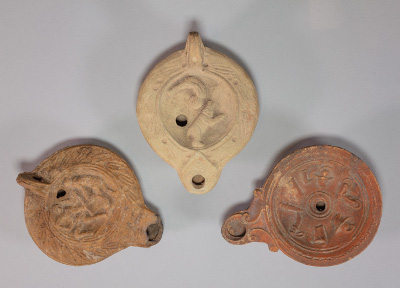
Three terracotta lamps
Unglazed Lamp with Gladiators in Relief
Roman Cyprus, late 1st century CE
Terracotta
1 1/4 in. x 4 1/8 in. (3.2 cm. x 10.5 cm.)
Gift of Mr. Dana C. Estes, Honorary Degree, 1902.3
Lamp with Relief Decorations of Gladiatorial Weapons
Roman Cyprus, late 1st century CE
Terracotta
1 1/8 in. x 4 1/2 in. x 3 5/16 in. (2.8 cm. x 11.43 cm. x 8.41 cm.)
Gift of Mr. Dana C. Estes, Honorary Degree, 1902.6
Lamp Showing an Acrobat Jumping over a Bear
Roman, 2nd century CE
Terracotta
1 1/8 in. x 4 7/16 in. (2.8 cm. x 11.3 cm.)
Gift of Mr. Dana C. Estes, Honorary Degree, 1902.4
These three terracotta lamps bear images related to popular events held in amphitheaters of the Roman Empire. The lamp on the left depicts two gladiators engaged in combat: a retarius, armed with a trident and a net, clashing against a secutor, armed with a shield and short sword. The retarius and secutor were a popular combat pairing in gladiatorial fights. The lamp on the right depicts various weapons and equipment commonly worn by gladiators. The lamp at center captures an acrobat leaping over a bear during a venatio. The venationes were hunts between a hunter and an animal, but at times may have incorporated acrobatics and animal handling activities as seen on this lamp. The illustrations of arena activities on household objects such as these inexpensive, mass produced molded lamps, demonstrate the widespread appeal of public arena spectacles in antiquity across all facets of Roman society.
(B. Wu)

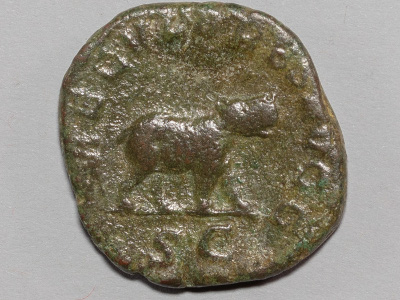
Sestertius of Otacilia Severa
Sestertius of Otacilia Severa
Roman, 244-249 CE
Orichalcum (ancient brass)
Gift of Mr. and Mrs. Mark M. Salton, 1988.44.107
Exotic animals such as the hippopotamus depicted on the reverse of this coin were a popular attraction in Roman public spectacles. Brought to Rome to dazzle the crowds, animals were used to help illustrate the expanding territories of the Roman Empire to the large public. This sestertius was struck to commemorate the inclusion of hippopotami in the Secular Games of 248 CE, organized to celebrate the 1000th anniversary of the founding of Rome. The obverse depicts the head of Otacilia Severa, the wife of Philip “the Arab”, the Roman Emperor from 244-249 CE.
(B. Wu)

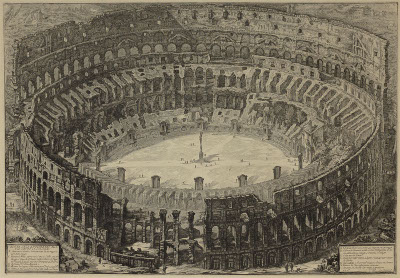
View of the Colosseum, Interior
View of the Colosseum, Interior
Giovanni Battista Piranesi
Italian, 1776
Etching and engraving on paper
19 5/16 in. x 28 in. (49.05 cm. x 71.12 cm.)
Gift of Charles A. Coffin, Honorary Degree, 1954.1.13
This 18th-century print by Giovanni Battista Piranesi (1720-1778) captures the ruins of the Colosseum, or Flavian Amphitheater, in Rome. Trained originally as an architect, Piranesi travelled throughout Italy recreating ancient remains through his prints. The keys in the bottom left and right of the print provide an interpretation of the ancient seating arrangements, which were decided by the gender and class of the individual, as well as noting some key features of the amphitheater. Holding up to 50,000 spectators, the Colosseum was the largest Roman amphitheater, constructed in Rome between 70 and 80 CE. Within the Colosseum, diverse events took place, including gladiatorial fights and naval battles.
(M. Brown)



